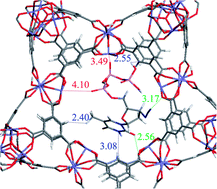Encapsulation of azidothymidine (AZT) or its phosphorylated derivatives (AZT-MP and AZT-TP) has been performed using nanoparticles of the porous crystalline iron(III) trimesate metal–organic framework MIL-100(Fe). The number of phosphate groups per nucleoside analogue has a high impact on the drug loading capacity, and their interaction with the Lewis acid sites from the nanoMOFs is also discussed through a combination of techniques such as UV-vis absorption, circular dichroism, isothermal titration calorimetry, HPLC and molecular simulations. Finally, the effect of the differences in terms of host–guest interactions is discussed through the release in physiological buffers of AZT, AZT-MP and AZT-TP. New perspectives for the nanoencapsulation of monophosphorylated nucleoside analogues for effective anti-cancer and anti-viral therapies are then discussed.

